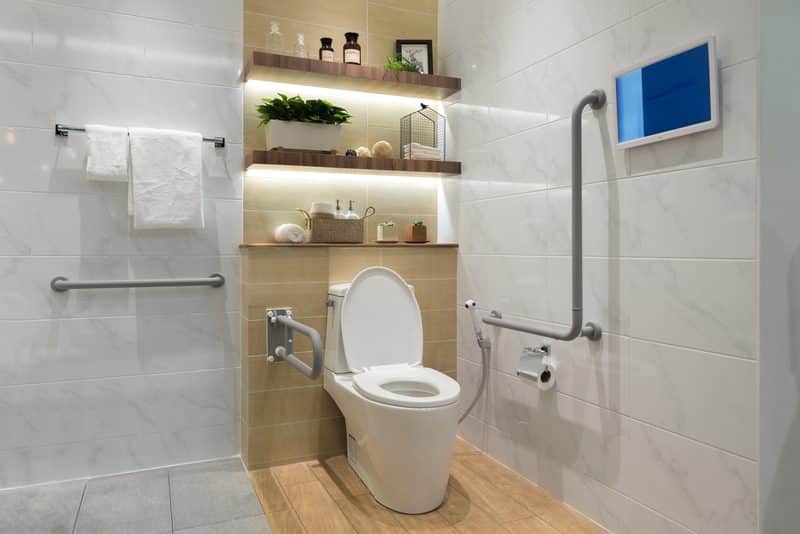An occupational therapy home evaluation soon after ALS diagnosis is essential to maximize quality of life for the few years a client has left.
By Bridget Scheidler, EdD, OTR, CAPS
Occupational therapists (OTs) are skilled healthcare practitioners who work with clients to maximize their quality of life throughout their daily roles and routines by addressing physical and mental dysfunctions. With these skills comes specialization in accessibility design as we strive for our clients to function independently and safely in their homes, in their workplaces, and within their communities.
As OTs, we work with a variety of clients throughout the lifespan with client-centered accessibility in mind based on the client’s condition, diagnosis, culture, lifestyle, age, social determinants of health, and so forth. One diagnosis that requires us to look through a unique lens when designing for accessibility is Amyotrophic Lateral Sclerosis (ALS), more commonly referred to in the United States as Lou Gehrig’s Disease.
Listen to more about home modification from Bridget Scheidler in Podcast: Aging in Place Home Modification Strategies Discussion
Clients diagnosed with ALS have a mean survival rate of two to five years with the fatal progressive neurodegenerative disease.1 Although ALS impacts all ages and ethnicities, men, whites, and those over 60 years old are more likely to develop the disease. Military service is also linked to a higher incidence rate compared to non-veterans.2 However, diagnosis can occur much earlier or later in life when clients are at various stages of their personal engagements and meaningful occupations. Due to the fast progression of the disease, early intervention is needed to maximize the client’s quality of life with their remaining time.
A Composite Case Study
To illustrate the time-sensitive need for home modifications and adaptations for a client with ALS, we will use a case example based on a few clients with ALS I treated in the past. All identifying features have been removed.
Gordon Williams is a 55-year-old male, Gulf War veteran, husband to Beth, and father to two young adults living away from home. He was recently diagnosed with ALS after around nine months of symptoms and subsequent testing to rule out other possibilities. He lives in a ranch-style home in North Carolina on six acres of land. He works as a farmer and his wife is a full-time lawyer.
Initial Assessment
After diagnosis, Gordon’s doctor referred him to a local ALS clinic where he received and will be receiving continuous robust healthcare services every three months. His doctor also wrote a referral for home health occupational therapy. Upon evaluation as the home health therapist, I discovered that Gordon is still independent around the home but has given up much of his farming due to the energy strain and fear of falling. He frequently drops items out of his hands and has decreased shoulder mobility. He experienced three falls without significant injury in the past two months.
A main concern for Gordon and Beth is that he remain independent for as long as possible with minimal pain. He became emotional when he informed me that his doctor stated that he “might only have a few years.” During the evaluation and subsequent sessions, I discussed the progression of the disease with decline of independence and need for modifications with consideration of Gordon’s current emotional and mental status and well-being. When Gordon was ready and with motivational interviewing, the main areas we addressed during the OT evaluation included:
- A tour of his home and farm to assess for accessibility and safety
- A discussion of his leisure, spiritual, and social activities
- Understanding his social support system
- A discussion of his preferred participation in IADLs such as cooking, driving, shopping
- Physical evaluation such as range of motion, strength, tone, balance, motor control, and sensation
- Cognitive and emotional screenings/assessments
Grants for Military Veterans
I informed Gordon of grants available for military vets diagnosed with ALS, and that it is considered a “service-connected disease.”3 Many veterans diagnosed with ALS qualify for 100% disability rate along with a $68,000 housing grant that can be applied to home modifications or payment toward their mortgages.3 I educated Gordon and Beth on the need for timely application of the VA grant to begin home modifications without delay to maximize Gordon’s independence and safety.

Home Modification Recommendations
On subsequent visits, I recommended both low- and high-cost home modification options based on Gordon’s goals and lifestyle. I began with universal suggestions such as ramps, grab bars in the shower and by the toilet, a raised toilet seat, and lowering Gordon and Beth’s high bed for ease of transfers and decreasing the risk of falls. I also educated the couple about clearing pathways for future wheelchair navigation and how Gordon would need to use thick straws for drinking liquids as well as a built-up toothbrush, utensils, and shed tools for an easier grip.
For higher cost items which the VA grant will help cover, I recommended construction of a roll-in, walk-in shower with no threshold that a shower chair can easily roll into; a Hoyer lift and a Hoyer lift system from bedroom to bathroom to assist Beth with future transfers; widening the bathroom doorway that is too narrow for a wheelchair; and changing the bathroom vanity to a pedestal sink for wheelchair access.
The speech language pathologist and I consulted on and discussed with Gordon the possible need for a communication device because he is beginning to slur his words and his verbal communication will most likely continue to deteriorate. I also informed the couple that the VA offers an $11,000 grant toward the purchase of a wheelchair-accessible van for veterans diagnosed with ALS.
Mobility Matters
Along with these suggested home modifications, I educated Gordon and Beth on assistive devices for functional ambulation such as a walker and a platform attachment to the walker if he loses grip strength. We also discussed the eventual need for a power mobility chair as the disease progresses.
As a veteran, Gordon is eligible for coverage of a power wheelchair. As the chairs take time for personal sitting and position and controls adaptations, I advised Gordon to begin the personalized wheelchair fitting quickly. The power wheelchair will allow for pressure relief positioning, ability to elevate the chair for certain activities, and different control options including a joystick, eye gaze, head control, or foot control depending on how the disease impacts Gordon’s body.
Making the Move
Within 6 months of the initial OT visit, Gordon and Beth were able to modify their home with suggestions from the full healthcare team. Although this is ideal for a client diagnosed with ALS, it is rare.
Many individuals diagnosed with ALS take time to mentally process the fatal reality of the disease and may be in too much denial to begin any home modifications. There is another factor that can delay adoption of needed modifications. Although ALS is twice as common in military veterans, there are over 5,000 new cases diagnosed each year in the United States4 and many individuals who are not vets do not have the funds for home improvements that will ease the way for this life-limiting illness.
Valuable Resources
Many clients with ALS attend a local ALS clinic about every three months where they receive follow-up from the healthcare team. These clinics may offer an “equipment closet” that includes mobility devices and adaptive equipment that was donated for future loan use. As part of your client’s rehab team, you will also want to contact their ALS clinic to ensure you are providing efficient interdisciplinary care with all team members. If your patient does not have access to the ALS clinic resource, or if they do but could use additional help, you can also assist clients in finding equipment from other sources such as ALS support groups. ALS.org provides information for local support groups along with advocacy and research areas where OTs and their clients with ALS can become involved.
As with any client, when working with someone who has ALS it’s important that OTs take a client-centered approach considering individual economic and social influences such as education, finances, physical environment, caregiver support, and access to healthcare. Some clients diagnosed with ALS choose to move from their homes to either be with a loved one who can help care for them or into an assisted living facility or nursing home where they will receive paid caregiver support throughout the disease progression. No matter the physical location, OTs want to ensure that they work with clients with ALS to find meaningful life engagements and support by identifying their clients’ and caregivers’ needs and goals while considering the disease process and environmental context.
If you’re an occupational therapist working in home modification and/or wheelchair fittings, you can also pursue additional certifications to increase your knowledge and skills in these areas.
The National Association of Home Builders provides a three-course program for therapists, interior designers, contractors, builders, and so forth to become a designated Certified Aging-in-Place Specialist (CAPS) to advance their knowledge of home design for prolonged safety and independence. OTs can also obtain an Assistive Technology Professional (ATP) certification through the Rehabilitation, Engineering, and Assistive Technology Society of North America (RESNA). This designation advances rehab professionals’ competencies with selecting and using assistive technology to promote the health and well-being of their clients and the users of the technology. RESNA also provides a Seating and Mobility Specialist (SMS) certification to rehab professionals that improves their abilities in seating and mobility assessments and interventions as well as finding funding resources.
Obtaining these certifications or contacting a rehab professional who has these certifications may be beneficial when working with a client with ALS to provide clinically excellent care. RM
Bridget Scheidler, EdD, OTR, CAPS, is a clinical assistant professor for Baylor University’s Occupational Therapy Doctorate (OTD) program. As an occupational therapist for over 16 years, she specializes in working with older adults. She became a certified aging-in-place specialist (CAPS) through the National Association of Home Builders in 2013. For more information, contact [email protected].
References
1. Mitsumoto H, Chad, DA, and Pioro EP. Amyotrophic Lateral Sclerosis. Philadelphia: Davis. 1998.
2. Weisskopf MG, Cudkowicz ME, and Johnson N. Military service and amyotrophic lateral sclerosis in a population-based cohort. Epidemiology, 2015. 26(6): 831-838. doi:10.1097/EDE.0000000000000376
3. ALS Association. FAQs. ALS.org. 2023. Accessed January 20, 2023 https://www.als.org/navigating-als/military-veterans/faqs
4. Centers for Disease Control and Prevention. CDC: Amyotrophic lateral sclerosis. CDC.gov. Published April 5, 2017. https://www.cdc.gov/als/WhatisALS.html





Your article on “ALS Home Modification: The Time is Now”
States VA housing grant for 68 Thousand dollars. Did you mean 68 hundred? HISA-Grants are for 6,800.00 with a 100% service connection.
The veteran may qualify for “Special Adaptive Housing” but that is an entirely different amount and process.
Thank you,
Hi Ed,
Thank you for your comment and question.
Per article author Bridget Scheidler, EdD, OTR/L, CAPS, the cited number, $68,000, is the correct amount.
Here is her response:
“In the reference that is associated with that number, it states, ‘Yes. Veterans and those on active duty who are service connected for ALS automatically are eligible for the maximum grant available under the VA’s Specially Adaptive Housing (SAH) program. The grants provide veterans with up to $68,000 to construct or adapt their homes, purchase an adapted home or pay down the mortgage on homes that already are adapted.’ It sounds like the HISA grants are a different grant.”
–Melanie Hamilton-Basich, Chief Editor, Rehab Management